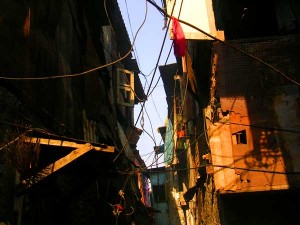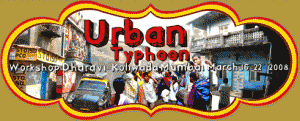
Who is not frightened by the idea of the unstoppable growth of cities in Asia and in the former “third world”, or by the perspective (apocalyptical, though critically framed) of moving towards a planet of slums? But in the places closer to this phenomenon – for example in the popular neighborhoods of Mumbai, India – the idea of slum has been criticized since many decades. These urban zones that don’t even deserve being called neighborhoods, always presented towards the exterior as marked by lacks (of hygiene, of safety, of integration, of control, even of morality), under a deeper scrutiny reveal histories and dynamics complex and functional, that had been interpreted in various forms according to the different theories. Based in an office in Dharavi-Koliwada (the enormous neighborhood popularized by Slumdog millionaire), the two urban activists Matias ECHANOVE and Rahul SRIVASTAVA (from Urbz collective) show how a series of spontaneous social structures, internal to the so-called slums, cause a constant improvement and development, often obstructed by local authorities or by urban reform plans. In territories as thick and reticular as forests of mangroves, the only valid ways to development are those generated by their very users: homegrown, as the neighborhoods themselves.
 The Urban Typhoon workshop [see PDF] create meeting points between activists and scholars living in the neighborhood and coming from abroad, to evaluate how the resources of the population can be instruments for an autonomous development. They are not slums, they are villages, explain the two organizers in their fascinating blog, airoots/eirut: Mumbai, portuguese colonial city, was built on a cluster of islands inhabited by fishing communities, one of those being the village of Dharavi-Koliwada. Even now that it has turned into one of the biggest neighborhoods of Asia, its narrow alleys are car-free zones serving as multipurpose spaces, defined by its users; its dwellings, rather than shacks, are “Tool-houses” (don’t miss this video!) that grow and adapt with time to the people that live in them; massive internal migration create complex networks of exchange and urban systems that also improve the quality of life in the home villages. The very discourse on slums as places of absolute misery, and its cinematographic version, turn into a self-fulfilling prophecy, an obstacle to the development of these places as homegrown cities, user-generated and user-mantained.
The Urban Typhoon workshop [see PDF] create meeting points between activists and scholars living in the neighborhood and coming from abroad, to evaluate how the resources of the population can be instruments for an autonomous development. They are not slums, they are villages, explain the two organizers in their fascinating blog, airoots/eirut: Mumbai, portuguese colonial city, was built on a cluster of islands inhabited by fishing communities, one of those being the village of Dharavi-Koliwada. Even now that it has turned into one of the biggest neighborhoods of Asia, its narrow alleys are car-free zones serving as multipurpose spaces, defined by its users; its dwellings, rather than shacks, are “Tool-houses” (don’t miss this video!) that grow and adapt with time to the people that live in them; massive internal migration create complex networks of exchange and urban systems that also improve the quality of life in the home villages. The very discourse on slums as places of absolute misery, and its cinematographic version, turn into a self-fulfilling prophecy, an obstacle to the development of these places as homegrown cities, user-generated and user-mantained.
- Rahul SRIVASTAVA & Matias ECHANOVE (2012) “Recognizing the user-generated city” [original english in airoots.org][spanish translation PDF]
- “Urbanistica collettiva: User-generated cities” (2012) Editorial on URBZ in italian, published in Domus n.955 [PDF][link]
- Ananya ROY (2011) “Slumdog cities: Rethinking subaltern urbanism”, International Journal of Urban and Regional Research, vol.35.2 [PDF]
- Owen M. LYNCH (1979) “Potters, plotters, prodders in a Bombay slum: Marx and meaning or meaning vs. Marx”. Urban Anthropology n.8 [PDF parcial]
- Alpita MASURKAR (2011) “A Community between point A and point B: Mumbai local trains” ColabRadio, MIT [link]
- Sangharsh Nagar la ciudad de la lucha, post on “El Antropólogo perplejo” blog